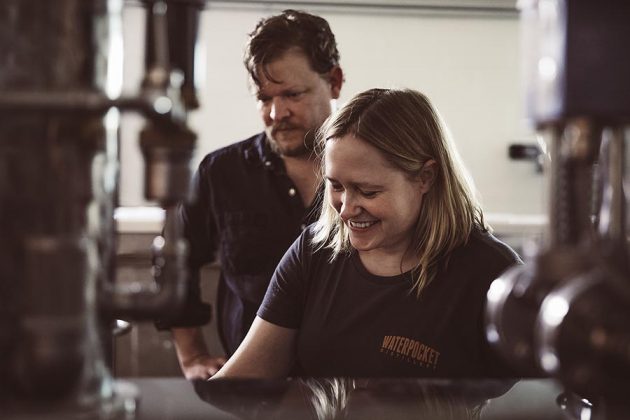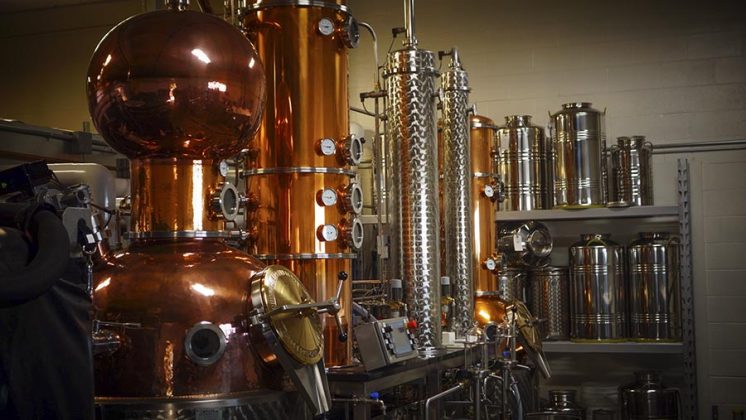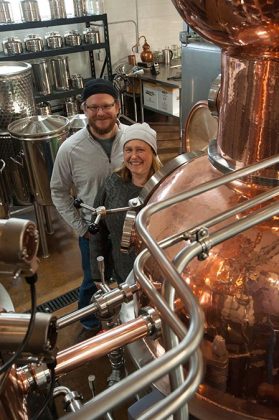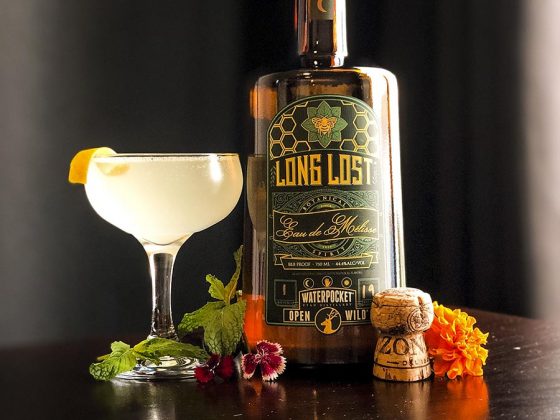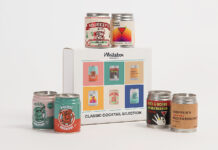How many categories of liquor are in your home bar? If you’re like most drinkers, you’ve got the basics covered: rum, whiskey, vodka, gin, tequila, brandy. The standard six. But, then again, you’re reading a magazine called Distiller. So let’s assume you’ve got some of the more marginal stuff squirreled away: mezcal, pisco, amaro, aquavit. Let’s even count vermouth as a spirit. You’re still struggling to reach a dozen. Alan and Julia Scott can count at least that many — among styles you didn’t even know existed. At Waterpocket Distillery, they specialize in resurrecting esoteric, Old-World elixirs that were lost to time. And they’re doing it in Utah, of all places.
The husband and wife team launched their operation along the industrial outskirts of Salt Lake City back in 2017. It was the culmination of decades’ worth of planning and the best kind of research. Throughout the ’90s the Scotts lived in Central Europe, tasting every regional spirit they could get their hands on.
“We discovered Izarra [a peppermint liqueur] on a road trip in Spain, drank Unicum [an herbal digestif] while we lived in Budapest and ordered flaming shots of (not great) absinthe in the bars of Bratislava,” recalls Mr. Scott. “Our Midwestern upbringing was relentlessly mundane in the flavor department, so I think we were predisposed to do some ‘adventure tasting’ when we ended up working overseas.”
All the while, they were developing an infatuation with botanical liqueurs. And by the time they reached Utah in the early 2000s, the seeds of a potential gin endeavor had been planted. It felt safe to pursue a known commodity, particularly in a state not exactly known for its cutting-edge drinking culture. Still, launching any sort of spirits brand in this part of the world was a risky proposition.
“Salt Lake was a town of basic bars, chain restaurants and only a couple of local ‘date-night restaurants’ where you could get a decent cocktail,” Scott recalls of the city then. “At that time, you had to have a sponsor to become a member of a ‘club’—meaning any place you could drink alcohol. All that has gradually turned into today’s vibrant scene as the laws have softened.”
It was a slow slog, but as they delved into the fundamentals of botanicals (with guidance from Master Distiller Stephen Gould of Golden Moon Distillery in Colorado), they continually came across curious recipes that had quite little to do with gin. “We found a rich set of resources from 19th-century France, Germany and Italy,” says Scott. “Some names kept coming up, and these included the Danziger spirits, Eau de Melisse and many others. As distillers, we felt we’d found a rich vein of new flavors beyond the boundaries of gin. And we decided to use the distillery to share some of these discoveries.”
What started as a personal desire to bring flavors on the page to life eventually took shape as Long Lost: an ongoing series of centuries-old spirits, almost all of which have never before been produced in the US. The debut label was the Oread — a 70-proof liquor influenced mainly by chamomile, star anise and orange peel. It is a faithful re-creation of Danziger, a root-infused liqueur that had been crafted in Gdansk since the 16th century.
“Highly esteemed in the old days, these were spirits produced by Mennonites in the old city of Danzig because of a unique set of cultural circumstances existing between 1600 and 1800,” says Scott, alluding to the religious freedom that the Protestant sect found in the region at the time. “But the culture changed and the area has been geopolitically transformed more than once, since. If there had been more continuity, I think they’d be much better known now.”
As it stands, there is only one producer in the world still bottling an entry into the category. And it’s no longer made in Poland. Scott’s rendition is based off of an entirely different recipe, countering licorice notes with the unctuous spice of ginger and the tingling pineyness of galanga. To maintain balance among these herbs and roots while surrendering nothing to vibrancy requires countless hours in the lab. At Waterpocket, this is actually just an open corner of the stillhouse, crowded with jars and test tubes. Here Scott gets to play mad scientist with tinctures and a rotavap (rotary evaporator).
How does he verify the accuracy of spirits which haven’t poured out of the glass for, in some cases, generations? The same way you do just about everything else: the internet. “Google Books is a treasure trove,” he admits. “For some individual spirits, since formulas and references varied across the sources, I began to make spreadsheets comparing ingredients, looking for the essential components and ratios across each interpretation. Everything else is work in the lab, sourcing and preparation of ingredients, etc.”
Despite the digital dependency, he’s still constantly on the lookout for primary sources via parchment, hunting down long forgotten texts from vintage booksellers. It was from one such weathered scroll that he stumbled upon a laudatory recipe for Eau de Melisse. Conceived as an herbal remedy in the south of France during the early 1600s, the digestif incorporates a maceration of freshly harvested lemon balm along with flowering hyssop and about a dozen other roots and herbs of varying intensity.
“What’s intriguing is that the spirit essentially turned into a perfume-oriented distillation in modern times,” according to Scott. “We tried it in the lab the first summer and were amazed at how distinct and interesting it was, like nothing else we’d ever tried.” Bottled at 88.8% ABV, it is at once bright and earthy, acidic yet herbal.
For the third — and most recent — release in the series, the Scotts set their sights on Milan. The Italian city commonly associated with bloodred aperitivos also birthed a distinctive peppermint-infused style of sipper in the mid-1800s, but it fell out of favor before the start of the 20th century.
“As distillers, it became a project about pulling the main ingredient — peppermint — back into complexity,” remembers Alan from the test phase. “Gin’s about finding flavors which work with juniper. For minthe, we thought the original distiller had some fascinating insights in how to produce flavors that work with peppermint, including cardamom, myrrh, angelica seed, mugwort, fresh orange peel and other complementary botanicals.”
In the absence of any added sugars, Minthe exists more as a base spirit rather than liqueur. It stands in the place of gin in popular recipes like fizzes and gimlets — immediately adding a Christmas-y tinge to the tipples.
From the beginning, it has been the local cocktail-crafting community that has championed the liquids of Waterpocket. Indeed, it’s hard to ignore the geek appeal of what the Scotts are doing. Not just with their resurrected categories, but also in Toadstool — a separate line of offbeat amari. The first entry therein was a German-inspired Kräuterlikör, with hints of rhubarb and clove.
“Historical botanical spirits are a niche of niche market,” allows Scott. “They require explanation, a tasting and some education to contextualize them for most customers. They often sit in the miscellaneous section of the liquor store — in other words: in the wilderness.”
But Waterpocket is riding the wave of Salt Lake’s rapidly developing bar scene. Defying stereotypes of their home state, it could be argued that they’re actually in the right place at the right time. “There’s plenty of people here hungry for the cultural diversity they see when they visit, say, Portland or Denver,” according to Scott. “In other words there’s a ready market for fun products from a craft brewery or distillery. We find our core audience for the Long Lost products among the local mixologist and cocktail enthusiast community. These folks have been very enthusiastic about our products.”
And now the rest of the country is catching up. Utah’s 13th licensed distillery just started exporting beyond state limits. Illinois was the first to receive shipment, and Scott sees California and the Pacific Northwest in the near future. Yet no matter how many states start stocking shelves with Kümmel (a caraway-infused liqueur) and Danziger, these styles will almost certainly remain the purview of connoisseurs. Reviving these obscurities is more passion than path to commercial clout. “We do other projects to keep the lights on,” Scott concedes. For now that includes distilling rum, light whiskey and — yes — a gin, out of his shiny copper pot stills.
What’s next? “Right now I’m getting very familiar with the botanicals in a group of elixirs based on genepi, iva, arnica and balsamite,” he says. “This year we’ll release a Boonekamp [think Underberg] style amaro in the Toadstool line. In Long Lost, we’re producing new batches of Eau de Melisse, hopefully with as many ingredients sourced here in Utah as possible.”
Research and development in the lab has also resulted in something altogether new for Long Lost in the imminent future. What category of bygone liquor will it belong to? Scott doesn’t seem too concerned with classifications just yet. It’s the experimentation that’s holding his interest. “Nice thing about working in new styles is there are no absolute rights or wrongs,” he says. “Not every creation needs to be Beethoven’s Fifth. Some can be more rock ’n’ roll.” Either way, if you’re in search of something outside the ordinary, at Waterpocket, it’s all music to your mouth.

